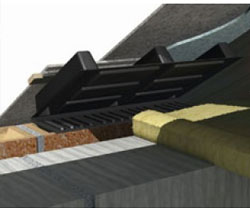Loft Eaves Ventilation
Properly ventilating your loft is important for protecting your family and your investment in your home. Whether you’re interested in selling your home or plan on staying in it for the foreseeable future, you want your home to stay in great shape so it maintains its full value. In order to make this happen, one issue you need to deal with is loft ventilation.
What are the Principles of Loft Ventilation?
While ventilation seems like a concept that’s extremely difficult to understand, it can actually be broken down into a few primary parts that are much easier to comprehend. The components that make this process a reality include:
Intake vents
Exhaust vents
Baffles
In order for a loft to be ventilated, it needs to receive a steady stream of fresh air. Intake vents take care of this important factor by ensuring there’s a place where outdoor air can flow into a loft. If air stays in a loft for a long amount of time, it’s going to get extremely hot. To avoid the problems that go along with this type of buildup, exhaust vents can be added to ensure that air is able to easily move out of this space. Baffles are the other component of a functional loft ventilation system. The reason they’re a necessary component of the ventilation process is because they ensure that nothing impedes the ability of air to consistently flow through a loft.
Is Loft Eaves Ventilation Right for You?
If you have a loft in your home, the answer to this question is most likely yes. The reason that you need to ventilate your loft is because failing to do so can cause problems for you. Not only can the excess heat that builds up in a loft lead to warping, but not taking care of this space can also result in mold growth. If this happens, it can cause damage and make it difficult for people in your home to properly breathe. While all of those issues are very frustrating, the one upside is that loft eaves ventilation can help you avoid them.
Are There Any Complications That Can Arise with Loft Ventilation?
Although there are a lot of benefits to loft ventilation, that doesn’t mean this process is guaranteed to avoid all potential complications. One common issue is that homeowners don’t realize that they’ve done something to reduce the effectiveness of their ventilation. While insulation and ventilation are designed to work with each other, that doesn’t mean you can simply throw insulation into your loft and call it a day.
If you accidentally cover your vents with rolls of insulation or blow insulation into them, you’re not going to get the results you want from your loft’s ventilation. Another common complication is homeowners’ assuming that they should add as much ventilation to their loft as possible. Even though this may sound good in theory, the reality is that going over the ideal amount of ventilation can actually reduce the effectiveness of this type of system.

Categories
- Home
- Loft Ventilation Products
- Ceiling Loft Ventilation
- Gravity Loft Ventilation
- Lindab Ventilation
- Loft Eaves Ventilation
- Loft Rotary Vents
- Loft Ventilation Fans
- Loft Ventilation Grilles
- Loft Ventilation Pipes
- Loft Ventilation Systems
- Roof Ventilation Tiles
- Small Loft Vents
- Loft Ventilation Companies
- Loft Ventilation Information
- Types Of Loft Ventilation
